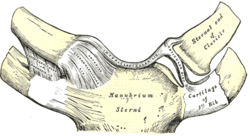Manubrium
| Manubrium | |
|---|---|
 | |
| Position of the manubrium (shown in red). | |
 | |
| Sternoclavicular articulation. Anterior view. From top to bottom, clavicles, first ribs and manubrium. | |
| Latin | Manubrium sterni |
| Gray's | p.120 |
| TA | A02.3.03.002 |
| FMA | FMA:7486 |
The manubrium (from Latin manubrĭum, "a handle") or manubrium sterni is the broad, upper part of the sternum. Located ventrally with a quadrangular shape, wider superiorly and narrower inferiorly, it articulates with the clavicles and the cartilages of the first pair of ribs.
Features
Borders
The superior border is the thickest and presents at its center the jugular or presternal notch; on either side of the notch is an oval articular surface, directed upward, backward, and lateralward, for articulation with the sternal end of the clavicle. The inferior border, oval and rough, is covered in a fresh state with a thin layer of cartilage for articulation with the body. The lateral borders are each marked above by a depression for the first costal cartilage, and below by a small facet, which, with a similar facet on the upper angle of the body, forms a notch for the reception of the costal cartilage of the second rib. Between the depression for the first costal cartilage and the demi-facet for the second is a narrow, curved edge, which slopes from above downward and medialward.
Additional images
-

Position of manubrium (shown in red). Animation.
-

Shape of manubrium. Animation.
-

Posterior surface of sternum.
-

Lateral border of sternum.
External links
| Wikimedia Commons has media related to Manubrium. |
| Look up manubrium in Wiktionary, the free dictionary. |
This article incorporates text from a public domain edition of Gray's Anatomy.
| ||||||||||||||||||||||||||||||||||||||